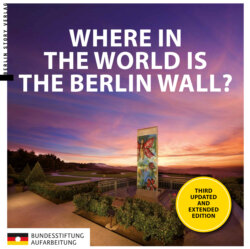Читать книгу Where in the World is the Berlin Wall? - Группа авторов - Страница 14
POLITICAL REACTION
ОглавлениеThe world held its breath. Would the West tolerate the massive operation at the most sensitive point of the “Iron Curtain”? Indeed, Willy Brandt was publicly criticising the closing of the border and referred to it on 13th August as an “outrageous injustice”, but could do little more than to call the protecting powers.27
The break with the Four-Power-Agreement by the Soviet Union was also a blow to Konrad Adenauer, Chancellor of the FRG. He made sure not to lose sight of the goal to reunify.28
Adenauer, however, came under criticism for his restraint, especially since he assured the Soviet Union that he would not take any steps that might further strain relations between the Federal Republic and the USSR and worsen the international situation. The situation was tense and fears grew that the outbreak of war was imminent. 300,000 citizens of Berlin gathered in front of Rathaus Schöneberg (in the West) on 16th August 1961. They called for serious action to be taken by the western powers and safeguards for West Berlin. The Allies had hardly reacted and anything they had done in reaction was only by means of verbal protest. The people’s discontent was evident on the banners: appeals such as “70 hours without action – doesn’t the West know what to do?” or “Paper protests don’t stop tanks”29 made clear the fears of having been abandoned by the West. Willy Brandt wrote a letter to the American President in which he wrote “Berlin expects more than words, Berlin expects political action”. Addressing the East, “all functionaries of the zonal regime, all officers and enlisted men”, Brandt appealed in his speech: “Don’t be made fools of! Display human behaviour wherever possible and above all do not shoot at your own people!”
On 19th August 1961, in an attempt to try and calm the people of West Berlin and in order to demonstrate that the island city could rely on him, John F. Kennedy sent Vice President, Lyndon B. Johnson, to Berlin. Accompanying him was General Lucius D. Clay, who had masterminded the Berlin Airlift. One day later, 1,500 U.S. troops arrived in Berlin to strengthen the troops already stationed there.
In his letter of reply, Kennedy wrote to Willy Brandt: “As this brutal closure of the border is a clear admission of failure and political weakness, it obviously means a fundamental Soviet decision that could only be undone by war.”30 The western powers did not wish to risk a war and were forced to respect the Soviet Union’s sphere of influence.The division of Germany now seemed permanently complete. The crisis in Berlin, however, did not end with the building of the Berlin Wall. When American officials were prevented from crossing the border at Checkpoint Charlie, tanks were put in place at the border crossing. It was not long before Soviet tanks were brought in and the two sides found themselves in a face-off. The stand-off lasted 16 hours, finally – as agreed upon in secret negotiations – the Russian tanks moved back first, followed by the American tanks.31 It became clear to the world that America had a right to be in Berlin, but could not do anything about the division of the city. America’s promise for a safe and free Berlin was strengthened on 26th June 1963 when President Kennedy visited West Berlin. The Berliners cheered him as he assured them of his solidarity by saying “Ich bin ein Berliner.”32
